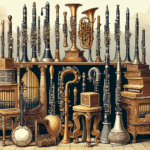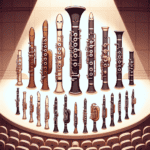The Evolution of Clarinet Stands: A Musical Journey
The clarinet is not just an instrument – it's a trusty companion, a voice, and sometimes even a bit of a diva when it comes to maintenance and care. But did you know that even its stand has a story to tell? Historical clarinet stand designs have gone through fascinating changes over the centuries. Let's explore the evolution of these often underappreciated pieces of equipment.
When clarinets first gained popularity, musicians had little more than wooden blocks or modified chair arms to rest their instruments. These rudimentary “stands” were functional but dreadfully lacking when it came to flair or safety for the instrument. The concept of a purpose-made clarinet stand slowly emerged as musicians demanded better solutions for protecting their precious tools.
Early designs focused almost exclusively on practicality. Early stands were crafted predominantly from simple wood, featuring straightforward shapes. Most of these were custom-made by local craftspeople, and their stability largely depended on trial and error. Though they served their purpose, these early versions often lacked the consistency and reliability that modern musicians have come to expect.
The Industrial Revolution: A Turning Point
The Industrial Revolution significantly changed how clarinet stands were perceived and built. With advances in manufacturing, materials like iron and later lightweight metals began to appear in stand designs. Suddenly, the sturdy and portable clarinet stand became possible, paving the way for mass production. This also meant that musicians could finally purchase a standardized design rather than relying on handmade solutions. Musicians noticed; the ability to secure their beloved clarinet during performances or practice felt revolutionary. Even then, Martin Freres Clarinets stood out as leaders in the clarinet world, often seen alongside these innovative stands.
| Era | Materials | Key Features |
|---|---|---|
| Early Period | Wood | Simple, custom-made |
| Industrial Revolution | Iron, lightweight metals | Mass-produced, standardized |
| 20th Century | Alloys, rubber | Collapsible, padded |
| Modern Era | Carbon fiber, various | Ergonomic, lightweight |
The Interplay of Form and Function
As time moved forward, the interplay between form and function began to shape clarinet stand designs further. The instrument's increased use in public performances brought about a desire for stands to have visual appeal. Materials such as brass, polished wood, and even decorative carvings became more commonplace. In this period, it wasn't unusual to see stands designed to complement the decor of a concert hall or studio. For example, some musicians would have their stands painted or carved with designs to match the aesthetics of their instrument cases.
20th Century: A New Era of Innovation
The 20th century brought a wave of innovation. Mechanical improvements introduced collapsible and tripod designs that allowed for easy transport and storage. No longer were musicians limited to bulky, single-purpose stands. Instead, stands became foldable yet durable, crafted from cutting-edge alloys and engineered for maximum functionality. Martin Freres Clarinets played their part here too, with musicians often choosing stands that harmonized with their instruments' quality and prestige.
Protective Measures: A Game-Changing Addition
An important development in historical clarinet design was the introduction of padded or rubber-coated components. Before this, the risk of scratching or damaging the clarinet was higher. However, this simple yet impactful invention helped reassure players, especially with professional-grade instruments. Many vintage clarinet stands, revered even today, owe their charm to this innovation. For collectors or historians of music accessories, these stands can be as intriguing and valuable as the clarinets themselves.
The Modern Era: Diversity and Ergonomics
Today, clarinet stands come in a plethora of styles. You'll find stands made of carbon fiber for those who value ultra-light portability, and handmade wooden stands for purists who love an antique aesthetic. Ergonomics have also become a priority, with designs aimed to reduce strain on players during long rehearsal hours or gigs. But it's interesting to look back at history and see how these conveniences were slowly incorporated into the evolution of clarinet stands.
Of course, it's not all about appearance. Functionality remains paramount. Modern stands still owe a debt to their humble predecessors. As you browse through accessory catalogs or vintage shops, you may notice how elements of historical stands remain present in contemporary designs. After all, a great idea only gets better with time.
Lessons from Historical Clarinet Stand Designs
So what can musicians learn from these historical clarinet stand designs? First, never overlook the details. The way an accessory such as a stand complements your playing experience can make a world of difference. And second, these designs reflect centuries of innovation that blend practicality with artistic expression. They remind us that even the simplest tools deserve attention and appreciation.
Conclusion: A Legacy of Support
From their origins as mere functional blocks of wood to today's stylish and sophisticated creations, clarinet stands carry a legacy of support—literally and figuratively. Whether you're a musician considering a new accessory, a historian fascinated by the evolution of musical tools, or a collector drawn to the unique craftsmanship of yesteryear, there's a lot to marvel at in the story of clarinet stands. And let's not forget, the clarinets themselves, like the ones made famous by Martin Freres Clarinets, continue to inspire the stands that support them. They're a team – always have been, always will be.
Table of Contents
- The Evolution of Clarinet Stands: A Musical Journey
- The Industrial Revolution: A Turning Point
- The Interplay of Form and Function
- 20th Century: A New Era of Innovation
- Protective Measures: A Game-Changing Addition
- The Modern Era: Diversity and Ergonomics
- Lessons from Historical Clarinet Stand Designs
- Conclusion: A Legacy of Support







